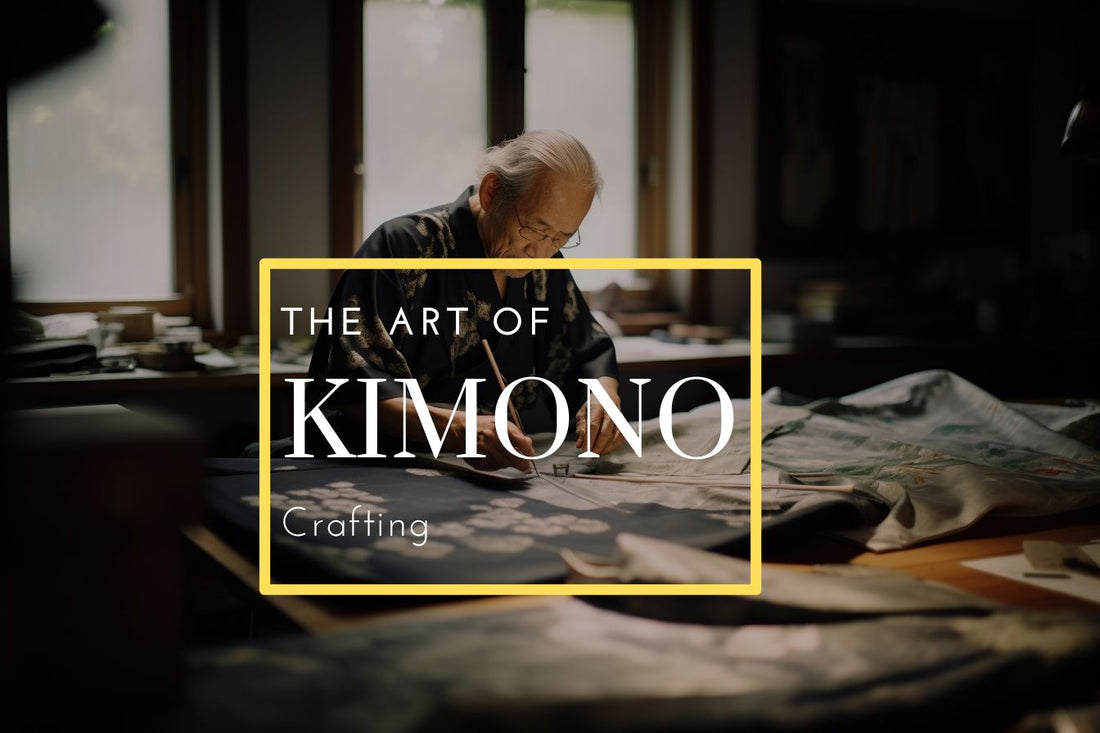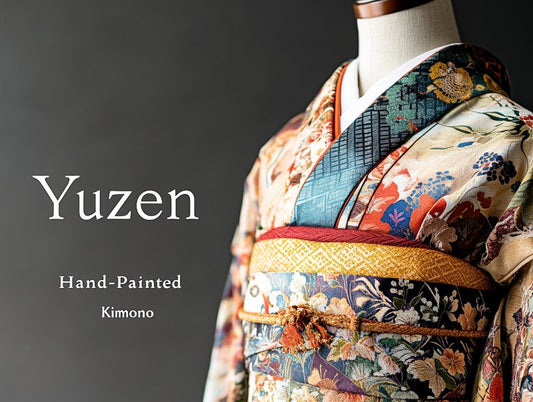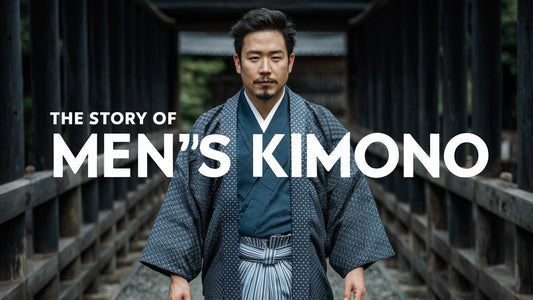
The Art of Kimono Making: A Comprehensive Walkthrough
Share
Introduction: A Glimpse into the World of Kimonos
Let us embark on a captivating journey, one that weaves through the cultural fabric of my homeland, as we explore the artistry of kimono creation. The kimono, a quintessentially Japanese garment, resonates with the essence of our cultural heritage. As one steeped in the culture and traditions associated with these garments, I am eager to unfold their beauty and elegance to you.
Historical Echoes and Cultural Undertones of Kimonos
The kimono, an emblem of Japan's aesthetic history, has evolved remarkably over centuries. Tracing back to the Heian period (794-1192), kimonos were born out of functional necessity. As time progressed, these garments acquired significant cultural symbolism, intricately embodying social status, personal taste, and the rhythmic ebb and flow of the seasons.
Various types of kimonos, each serving specific occasions and worn by different age groups, genders, and during particular seasons, beautify the Japanese landscape. The Furisode and Homongi, formal kimonos stitched with high-quality silk and intricate designs, embody a sense of grandeur. Meanwhile, the Yukata, a casual and comfortable cotton variant, is a popular choice for the sweltering summer months.
The Canvas and Colors of Kimono Making: The Materials
As much as the kimono is an art form, the selection of its material is an art in itself. The choice of fabric sets the mood for the garment, with silk holding the crown as the most desired.
Choosing the Palette for Kimono Artistry: The Materials
The journey of kimono creation starts from the selection of the right fabric, a critical decision that lays the groundwork for the final masterpiece. While the material must meet functional requirements, it also carries the aesthetic message of the kimono. The chosen fabric type introduces us to the universe of textures and shades, each kind offering its unique contribution to the kimono's overall aesthetic.
The Majestic Silk: An Enduring Choice for Kimonos
Silk, with its multitude of varieties, brings an unmatched texture and sheen to the kimono. The choice of silk for a kimono is not a recent trend, but a tradition steeped in centuries of Japanese history. Revered for its luxurious feel, the silk kimono remains the most sought-after choice for formal occasions and ceremonies.
Habutae Silk: The Echo of Elegance
Habutae, a variety of silk traditionally made in Japan, is renowned for its smooth, glossy surface and soft, delicate touch. Its shimmering quality adds an elegant glow to the kimono, making it a preferred choice for ceremonial garments. Habutae silk's lightweight and flowing nature drapes beautifully, emphasizing the kimono's structural aesthetics.
Rinzu Silk: The Epitome of Sophistication
Rinzu silk is another favorite in the world of kimonos, appreciated for its damask-like, lustrous finish. Its complex weaving technique results in subtle, intricate patterns that catch the light, adding a dimension of sophistication and depth to the kimono.
Ro Silk: The Breeze of Comfort
Ro silk, with its distinctive open weave, is a staple for summer kimonos. Its unique construction allows for better air circulation, making the kimono breathable and comfortable during Japan's hot summer months. Despite its airy structure, Ro silk maintains an alluring sheen that beautifully complements the summer sunlight.
Beyond Silk: Cotton and Synthetic Fabrics in Kimono Making
While silk holds the throne in the realm of traditional kimonos, other materials like cotton and synthetic fabrics have also found their place in this art form, fulfilling diverse needs and preferences.
Cotton: The Breath of Freshness
Cotton, known for its breathability and comfort, is a popular choice for crafting Yukatas, the casual version of kimonos. Ideal for summer festivals and informal occasions, cotton kimonos offer a blend of comfort and style. The natural absorbency of cotton makes it perfect for warm weather, providing a cool and fresh feel.
Synthetic Fabrics: The Wave of Practicality
In the era of modernity and practicality, synthetic fabrics have gained a foothold in kimono making. Materials like polyester and rayon are favored for their affordability, durability, and ease of maintenance. The resilience of synthetic fabrics to creasing, coupled with their ability to replicate the appearance of traditional materials, make them a practical and appealing option for everyday kimonos.
The Symphony of Kimono Making: The Process
Crafting a kimono involves a meticulous sequence of steps, each significant in transforming a piece of fabric into an emblem of cultural beauty. This process is a harmonious symphony of time-honored techniques, an intricate blend of art and craft, patience and skill, tradition and innovation.
Setting the Stage: Preparing and Dyeing the Fabric
The kimono making process commences with the careful preparation and dyeing of the fabric, a crucial stage that infuses the garment with life and color.
Yuzen: Painting Dreams onto the Fabric
The Yuzen technique is a traditional method used to breathe life into a kimono, creating a canvas of dreams on the fabric. Named after Miyazaki Yuzensai, a 17th-century fan painter, the Yuzen method involves a complex process of sketching, resist-dyeing, and painting.
In the first step, artisans draft elaborate designs onto the fabric using freehand sketches or stencils. Subsequently, a resist paste, typically made from rice, is applied along the sketch lines to prevent the dye from bleeding into unwanted areas.
The fabric then undergoes a series of dyeing, each color requiring a separate round of applying resist paste and immersion in dye. Lastly, the design is accentuated with hand-painted details, transforming the fabric into a vibrant tableau of the kimono's story.
Shibori: Crafting Patterns through Resist-Dyeing
Shibori, another resist-dyeing technique, contributes its unique aesthetic to kimono artistry. The term Shibori stems from the Japanese verb 'shiboru,' which means 'to wring, squeeze, press.' The process involves manipulating the fabric through techniques like folding, twisting, and compressing before it is dyed.
When the fabric is unfolded post-dyeing, the areas previously compressed reveal mesmerizing patterns, each fold and twist contributing to the visual charm of the finished kimono. The Shibori technique results in a variety of patterns, from subtle textures to bold, geometric designs, each with a captivating uniqueness.
Assembling the Artwork: Sewing and Construction
After the dyeing process, the fabric undergoes the transformative stage of sewing and assembly. One striking characteristic of kimono construction is its logical and eco-friendly design. The kimono is composed of straight pieces of fabric, aligned and sewn together to form a T-shaped garment.
Cutting and Aligning: Mapping the Kimono's Structure
The kimono's structure is incredibly efficient and waste-free. The fabric is cut into seven straight pieces – two panels for the body, two panels for the sleeves, two strips for the front panels, and a thinner strip for the collar.
The alignment of these pieces is critical, as it defines the kimono's balance and symmetry. The panels are meticulously arranged to form the body, while the strips shape the collar and the front opening of the kimono.
Sewing and Finishing: Crafting the Masterpiece
Once cut and aligned, the pieces are carefully sewn together. The seams and edges are neatly finished, ensuring the garment's longevity and wearability.
The kimono's design facilitates disassembly for washing and resewing, an advantage considering the delicate materials and elaborate designs. After cleaning, the kimono can be resewn, ready to grace another occasion with its timeless elegance.
This final stage wraps up the symphony of kimono making, marking the birth of a garment that is much more than a piece of clothing – it is a piece of art, a piece of history, and a piece of the Japanese soul.
A Dance between Tradition and Modernity
Kimono making has gracefully accepted the rhythm of modernity without losing its traditional essence. Today, we witness a harmonious blend of traditional craftsmanship with modern technology. Machine sewing and digital printing technologies have been adopted alongside traditional practices to ensure efficiency and cost-effectiveness.
The Global Reflection of Kimonos in the Fashion Industry
As kimonos paint a vibrant stroke on the canvas of Japanese culture, their aesthetic allure hasn't gone unnoticed in the global fashion scene.
Kimono-inspired fashion is a testament to the universal admiration for these garments. Designers worldwide incorporate the unique kimono aesthetic into contemporary fashion, resulting in an enthralling fusion of the East and West.
Beyond formal occasions, kimonos have found their place in everyday wear outside Japan. People around the world are exploring the charm of these garments, weaving them into their wardrobes for their comfort, adaptability, and the distinctive style they offer.
Looking Ahead: The Future of Kimono Making
The art of kimono making continues to bloom, with the global fascination for these garments showing no signs of waning. In an era increasingly invested in sustainable fashion, the traditionally-crafted kimono, celebrating natural materials and techniques, holds a significant place.
Conclusion: Wrapping Up the Journey
The craft of kimono making is more than just creating a garment; it's a testament to Japan's rich cultural heritage, encapsulating the profound aesthetics of simplicity, subtlety, and sophistication. This journey provides a deeper understanding of how these beautiful garments come to life, carrying the spirit of Japan within their folds.
FAQs
-
What is the most costly aspect of a kimono? The fabric, especially when crafted with high-quality silk and hand-dyed using traditional methods, accounts for the most significant expense in kimono making.
-
How much time does it take to create a kimono? The time taken to make a traditional kimono varies widely, ranging from a few weeks to several months. This duration depends on the design's complexity and the techniques employed.
-
Can kimonos withstand machine washing? Traditional silk kimonos should never be machine washed. They are typically disassembled and cleaned by professionals. However, casual kimonos such as Yukatas, made from cotton or synthetic materials, can often be machine washed.
-
Why do kimonos come with a high price tag? The pricing of kimonos reflects the premium materials used and the skills and time required in their creation, particularly when hand-sewn and hand-dyed.
-
Is it culturally appropriate to wear kimonos outside Japan? Yes, wearing kimonos is acceptable outside Japan, provided they are donned with respect and understanding, not as a caricature of Japanese culture. The global appeal of these garments is reflected in how they've found a place in the wardrobes of many non-Japanese individuals, a sign of cultural appreciation.


